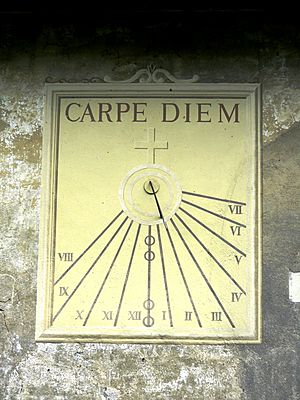Carpe diem facts for kids
Carpe diem is a well-known Latin phrase. It comes from a poem written by Horace, an ancient Roman poet. The phrase means "seize the day." It encourages people to make the most of the present moment.
What Does Carpe Diem Mean?
The idea of "Carpe diem" became very important during a time called the Baroque era. This was especially true in the 17th century. During this period, a big conflict called the Thirty Years' War happened. It lasted from about 1618 to 1648.
Life was often very difficult and uncertain for people back then. They saw a lot of hardship and loss. Because of this, ideas like "Carpe diem" helped them cope. It meant: "There isn't much time, so use it as best you can."
Other similar ideas were also popular. Vanitas meant that things might not be what they seem. Memento mori reminded people to "remember you will die." All these ideas encouraged people to think about life's short time. They wanted to live fully and appreciate each day.
Horace's original poem is from his collection called Odes. It talks about not worrying about the future. Instead, it suggests enjoying the present moment.
A Better Translation
While "seize the day" is a common translation, a more exact meaning might be "pluck the day." Think of it like picking a fruit from a tree. You pick it when it is ripe and ready to enjoy. This idea suggests gathering the good things from each day as they happen. It means to make the most of opportunities right now.
Images for kids
-
Gather Ye Rosebuds While Ye May, by John William Waterhouse
See also
 In Spanish: Carpe diem para niños
In Spanish: Carpe diem para niños



